The proof of concept is here: remote work works.
According to Gartner, 88 percent of global organizations made it mandatory or encouraged their employees to work from home during the COVID-19 pandemic. Some corporations welcomed teams back to reconfigured, socially distanced office spaces over the summer, while tech firms such as Facebook and Google are giving many employees the flexibility to work from home through 2021.
As more people return to offices part-time, full-time, or with hybrid arrangements, what tools and policies will prove to be essential? What lessons have we learned about UCC, AV, and visualization technologies and team morale during the pandemic? How can AV specialists add value on the corporate campus, even as videoconferencing platforms continue to be the default meeting method for geographically separated employees?
New Workflows
Microsoft Teams, Cisco Webex, Zoom, and soft codecs of their ilk had been deployed in the enterprise for many years before the pandemic, but the crisis hastened their proliferation. “There have been various players and peripherals” for some time, according to Akintayo Adewole, CTS, design engineer at Verrex.

The crucial difference in 2020: enterprise technology specialists have had to “stop prophesying and simply make it all work, make it secure, and focus on delivering a better experience,” Adewole said.
Paul Konikowski, CTS-D, agreed. Konikowski—who works for HB Communications, number 13 on SCN's 2020 Top 50 list, as a manager of AV contracting—is currently completing an online Master of Science degree program from the School of Cybersecurity and Privacy at the Georgia Institute of Technology (Georgia Tech). He has been tracking the rapid workplace migration to digital communications—and the speed and scope of the shift. He’s observed how the pandemic has spurred a “dramatic adoption of collaboration tools like Microsoft Teams and Zoom,” which is notable “because it has changed our entire workflow,” Konikowski said.
“Persistent Chat Culture”
Videoconferencing soft codecs give employees the continuity of face-to-face meetings. Cloud-based solutions let people collaborate in sync on projects of all sizes. And for chatting, employees are leveraging Slack and tools like it. The result is an agile “persistent chat culture,” Konikowski noted, that keeps teams engaged, either asynchronously or synchronously.

AV specialists can help companies center the persistent chat culture as more workers return to the corporate campus. “People using Zoom and Slack are no longer ‘early adopters,’” Konikowski said, suggesting that workers will want to “seamlessly carry home office methods, tools, and workflows back into their [physical] offices.”
Konikowski pointed to products like large-format displays that will let employees socially distance without missing important information on the screen. Additional displays might be needed to showcase each element of the remote, on-site, and hybrid work ecosystem. Dashboard stats, access to camera feeds, webinars, live tweets, and chat streams are just a few of today’s standard work features. AV specialists can add value in an enterprise project by creatively merging these disparate but important elements.
To that end, Konikowski expects to see more interest in “voice control and solutions like confidence monitors and teleprompters in front of cameras that show the far end participant so more direct eye contact can be made.” These kinds of technologies and designs will meet the needs of today’s workforce and keep pace with changing behavior. Unified communications and collaboration (UCC) tools can create a bridge into hybrid or flex environments.
Prioritizing Health and Safety
Another enterprise trend is the visualization of health and safety information inside the office, according to Konikowski. He cited new protocols pertaining to COVID testing as an example. These measures can make corporate wellness policies more transparent while helping employees feel safe and valued. Open air and natural lighting are also encouraged.
Immersive and Experiential
On the corporate campus, in the home office, or in satellite branches, “people crave being more engaged and collaborative in meetings. Immersive applications can help with that,” said Adewole. Corporations and integrators need to better understand the immersive space, which includes VR (virtual reality), AR (augmented reality), and MR (mixed reality).
Adewole connected advancements in VR technologies to dropping price points for wearables such as headsets, and the implementation of more robust communications infrastructure such as 5G and Starlink. VR has been increasingly popular for gaming during the pandemic and is consequently enabling other emerging applications. Consumers can procure high-quality wireless VR headsets for $300 or less. “People now have more affordable access to this technology. Participation and the development of more immersive business applications is soon to follow,” Adewole predicted.
While some sectors have been slow to invest in XR/MR, a few companies have hit the ground running. Adewole noted that architectural engineering and construction firms (AEC), for instance, can leverage emerging technologies and see immediate benefits. Pair AR or VR with prototyping for a distributed team around the world and “you would be able to take an architectural model and turn it into a more immersive experience for clients. You could walk around in three-dimensional space, mark it up, and annotate, all within a virtual yet photorealistic experience.”
Now apply this creative paradigm to corporate communications and broadcast. High-quality cameras, spatial audio, and immersive storytelling technologies could add value to live events, Adewole suggested. Imagine more experiential shareholder presentations, all-hands meetings, and corporate Facebook Live streams. “It’s time to start thinking bigger and more creatively about this space,” he added.
Advanced Intelligence Built into Devices
Jason Jacoby, CTS, associate with Shen Milsom & Wilke, sees a similar trend with AI on the corporate campus. Indicated by the wider availability of AI-enhanced solutions, and by recent acquisitions, vendors see the value in incorporating AI into AV components. “It’s so exciting to see the industry really trying to expand, going beyond just putting a microphone on a table,” Jacoby said.

He highlighted AI’s benefits, particularly with enterprise audio: “You can define the area in which a specific microphone is listening. AI microphones can track a person around the room. You can put a great soundbar on a wall and stand 15 feet back in that room and the audio is still completely intelligible. This is a great step forward to requiring less physical control touchpoints in rooms.”
Less Equipment in Rooms
“As employees start filtering back into offices, and after the next cycle of refreshes, expect to see less physical equipment in rooms,” according to Jacoby. “We’ve gotten to the point where it is possible in all but the largest of rooms to move just about everything beyond the network and into the cloud, including DSP. You can have very advanced programs on the network without the need for a physical device, and have a mini PC mounted behind the monitor or in a rack down the hall. The foundation of the space is now beyond the local devices, including network switches and routers, and at the software level.”
Purpose-Driven Workspaces
The key in 2021 will be “leading with the use case,” said Frank Padikkala, CTS-D, AV design engineer with Diversified. Focus on creative solutions and “purpose-build rooms guided by the use case,” he stated.

“The design engineer in me appreciates a purpose-built room,” he said. Previously, there may have been an appetite for—or at least a high tolerance for—a generic conference room. Now, Padikkala said, “We are all asking what we’re trying to do in each space—recording, streaming, or remote work, for instance—and then leading with that use case and those user needs.”
AVoIP
IT’s relevance in the pro AV industry is writ large, but the pandemic has laid bare the critical importance of security, data, connectivity, remote access, and network reliability. “It is essential that AV firms continue to level up with IT skills training, cybersecurity, and network expertise,” Padikkala said. “There is still a skills divide.”
[The Integration Guide to AVoIP]
Opex
Another long-term benefit to investing in AV over IP and cloud-based applications is the ability to tap into the opex (operating expense) budget versus capex (capital expense). During cash-strapped times—pandemic and beyond—an opex approach makes logistical sense, Padikkala suggested.
Bringing the Office to You
Padikkala is grateful that the shift to remote working “bridged a gap,” he said. The new world of work relies on technology, but Padikkala also sees it as a “cultural evolution.”
“We all must take a more holistic approach to the idea of work and workspaces.”
Jacoby took that sentiment a step further: “The next level is really about bringing the office to the employees, rather than the other way around.”

